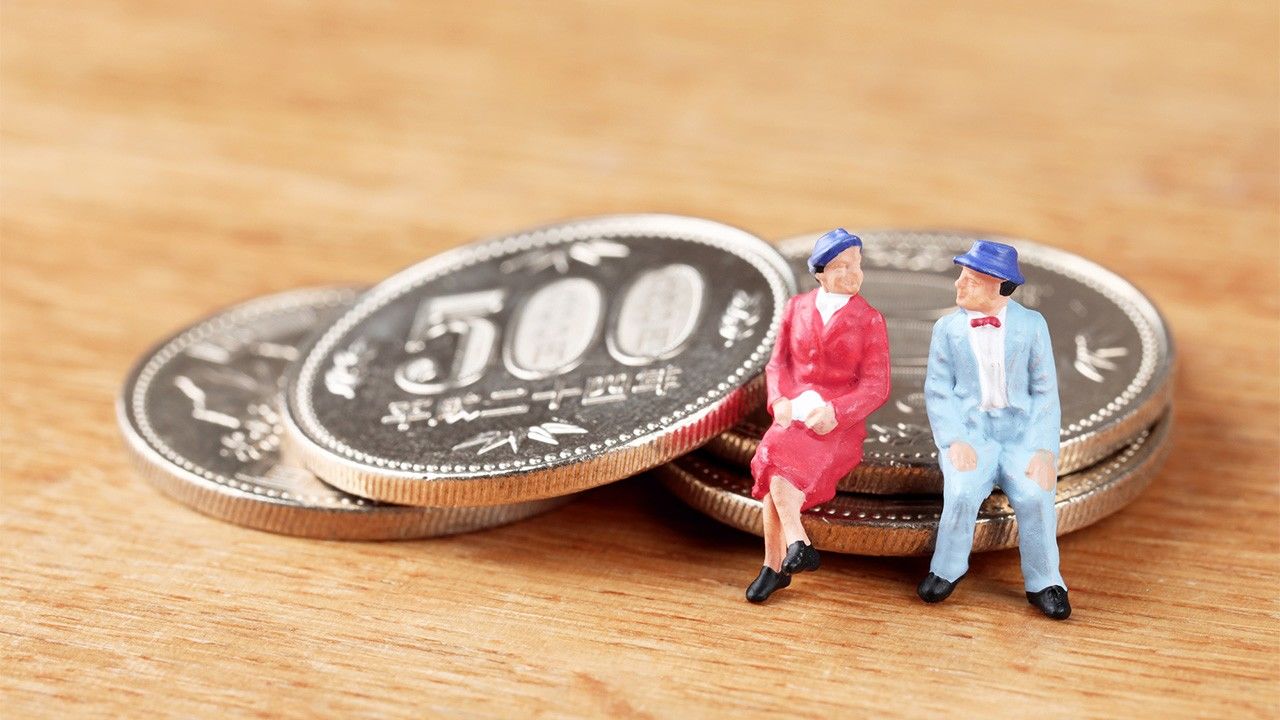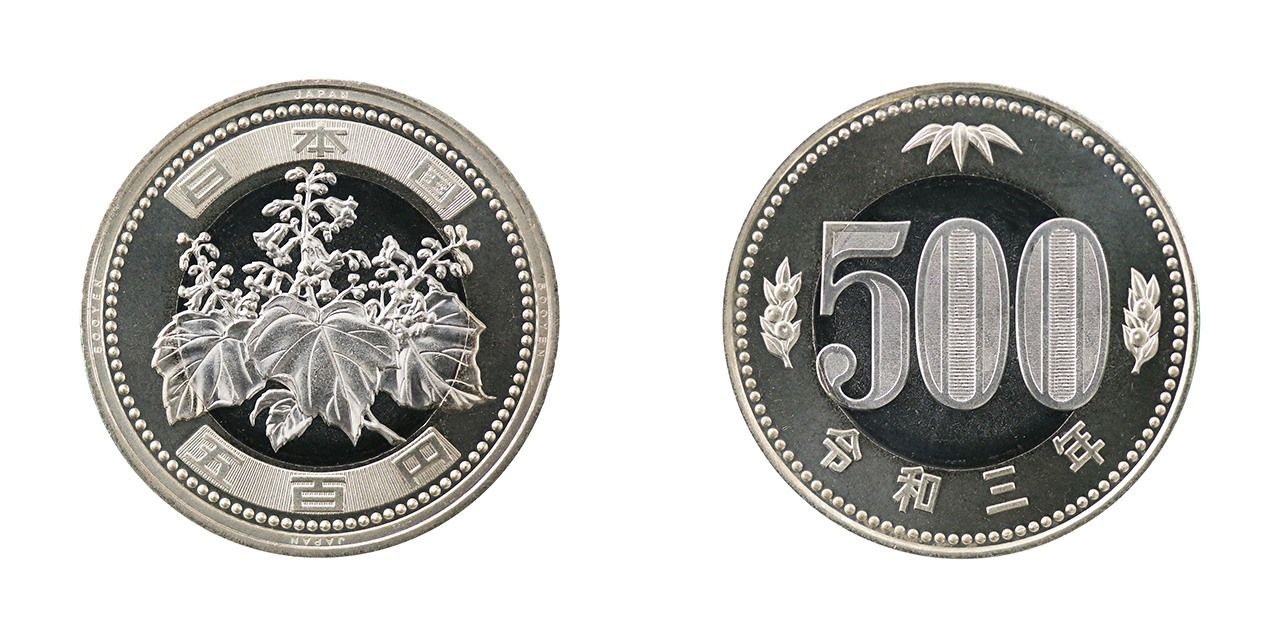
Japanese Coins
Society Culture- English
- 日本語
- 简体字
- 繁體字
- Français
- Español
- العربية
- Русский
Japanese Coins Large and Small
Japan has six coins in circulation with values ranging from ¥1 to ¥500. The front, or obverse, side of each features a different image, normally a variety of plant such as a stalk of rice or chrysanthemum blossom, and the reverse side displays the date of minting, expressed by the year in the reign of the emperor (for example, 2024 is Reiwa 6). Unlike many types of currency, the different yen denominations have not been blessed with nicknames and are normally referred to merely by their value followed by the word endama (yen coin).
In common parlance, the term kozeni normally signifies ¥100 and ¥500 pieces, but can also denote pocket change of any size. Unlike Japanese paper money, which is printed by the Bank of Japan, coinage is manufactured under the authority of the Japan Mint, an independent arm of the national government.
While the use of credit cards and e-money has grown, cash is still in common use for expenditures such as grocery shopping and eating out. Larger denominations are relied on most, but following the introduction of a national consumption tax in 1989, prices began to be calculated down to single-yen units, ensuring a place for even the lowly ¥1 piece in the nation’s change purses.

New ¥500 coin. Obverse: paulownia. Reverse: bamboo at top and mandarin orange branches at the sides. (Courtesy of the Japan Mint)
 Old ¥500 coin. Obverse: paulownia. Reverse: bamboo and mandarin oranges. (Courtesy of the Japan Mint)
Old ¥500 coin. Obverse: paulownia. Reverse: bamboo and mandarin oranges. (Courtesy of the Japan Mint)
 ¥100 coin. Obverse: cherry blossoms. (Courtesy of the Japan Mint)
¥100 coin. Obverse: cherry blossoms. (Courtesy of the Japan Mint)
 ¥50 coin. Obverse: chrysanthemums. (Courtesy of the Japan Mint)
¥50 coin. Obverse: chrysanthemums. (Courtesy of the Japan Mint)
 ¥10 coin. Obverse: Phoenix Hall at the Byōdō-in temple. Reverse: tokiwa (evergreen) tree. (Courtesy of the Japan Mint)
¥10 coin. Obverse: Phoenix Hall at the Byōdō-in temple. Reverse: tokiwa (evergreen) tree. (Courtesy of the Japan Mint)
 ¥5 coin. Obverse: rice stalk, gear, and water. Reverse: leaf sprouts. (Courtesy of the Japan Mint)
¥5 coin. Obverse: rice stalk, gear, and water. Reverse: leaf sprouts. (Courtesy of the Japan Mint)
 ¥1 yen. Obverse: sapling. (Courtesy of the Japan Mint)
¥1 yen. Obverse: sapling. (Courtesy of the Japan Mint)
Japanese coins are also imbued with different design aspects intended to prevent counterfeiting. In particular, the new ¥500 piece, introduced in November 2021, has a complex structure using three types of metal and ridges around the edge set at different angles.
“JAPAN” and “500 YEN” appear in two positions each around the edge of the coin.
When viewed from above at different angles, the “latent images” “JAPAN” and “500 YEN” appear within the zeroes of the “500.”
Design and Meaning
The ¥1 piece is the oldest of modern denominations, first appearing in 1955, and is the only one that has kept its original design; the sapling on the obverse side is said to symbolize the growth of the country. Center holes adorning ¥5 and ¥50 coins are a feature seen in Japanese money since early times, first appearing on the Wadō kaichin coins of the sixth century. The ¥50 piece was minted without a hole prior to 1959, but was pierced to distinguish it from the ¥100, which is similar in size.
Ridges appear on the edges of ¥50, ¥100, and ¥500 coins as well as ¥10 varieties minted from 1951 to 1958. The latter, nicknamed gizajū (jagged 10), remain in circulation but are mostly a novelty for collectors, having the same value as their smooth-sided comrades. On ¥500 coins minted from 1982 to 1999, the ridges were replaced by writing spelling out “NIPPON 500.” Other somewhat rare varieties are coins minted in Shōwa 64 (1989), as the reign year lasted less than a month. It ended when Emperor Shōwa (Hirohito) passed away in January 7 of that year.
Japanese coins are also imbued with different design aspects intended to prevent counterfeiting. In particular, the new ¥500 piece, introduced in November 2021, has a complex structure using three types of metal and ridges around the edge set at different angles.
Coins for the Gods
Saisen bako (offertory boxes) are common sights at temples and shrines. Traditionally, worshippers drop a few coins into these receptacles as an offering prior to praying. According to one theory, the preference of metallic over paper denominations comes from a belief that the jingle of coins as they tumble into the saisen bako will draw the attention of the gods to a parishioner’s prayer.
The ¥5, or go-en, piece is frequently the coin of choice for both casual visitors and the devout, as the word goen can also mean “a karmic connection.” Depending on the earnestness of prayers, however, larger offerings may also be presented, such as ¥10,000 proffered to ensure divine benevolence in the New Year.
One-Coin Shopping
Even a few Japanese coins can go a long way. A number of stores in business and shopping districts offer customers “one-coin” services, such as lunch sets, parking, dry cleaning, and meeting room rentals, for a single ¥500 piece. While 100-yen stores also theoretically provide patrons with one-coin shopping convenience, settling the tally after adding consumption tax (currently 10% in most cases, but sometimes 8%) does require some extra change.
Commemorative Coins
Over the years, Japan has issued over a hundred different commemorative coins to celebrate special events, including the anniversary of the emperor’s enthronement, the semicentennial of the shinkansen, and different Olympic Games held in the country, with denominations ranging from ¥100 to ¥10,000.
 A ¥10,000 coin issued in 2009 to commemorate the twentieth anniversary of Emperor Akihito’s enthronement. (Courtesy of the Japan Mint)
A ¥10,000 coin issued in 2009 to commemorate the twentieth anniversary of Emperor Akihito’s enthronement. (Courtesy of the Japan Mint)
 The ¥1,000 shinkansen fiftieth anniversary commemorative coin issued in 2014. (Courtesy of the Japan Mint)
The ¥1,000 shinkansen fiftieth anniversary commemorative coin issued in 2014. (Courtesy of the Japan Mint)
(Banner photo © Pixta.)


